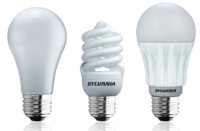 My wife and I went shopping at the local hardware store for something completely random, and instead bought a pre-lit 6.5′ christmas tree. Normally $170, marked down to… wait for it… $10! Sold. Anyway, it came pre-lit with 300 mini incandescent lights. There was no option for an unlit tree at that cost, so we figured we’d just “unlight” it, and relight it. But before that, I thought I’d use my handy Kill-a-Watt (Thinkgeek right now is the cheapest place to get one, otherwise I’ve bought two of them from here) and see how much power 300 mini lights use.
My wife and I went shopping at the local hardware store for something completely random, and instead bought a pre-lit 6.5′ christmas tree. Normally $170, marked down to… wait for it… $10! Sold. Anyway, it came pre-lit with 300 mini incandescent lights. There was no option for an unlit tree at that cost, so we figured we’d just “unlight” it, and relight it. But before that, I thought I’d use my handy Kill-a-Watt (Thinkgeek right now is the cheapest place to get one, otherwise I’ve bought two of them from here) and see how much power 300 mini lights use.
The answer, 102 watts (0.34W/bulb)! That’s 2.448KHW/day (assuming 24 hour use), or $0.1133/day. Damn. Could you imagine the old days when people put C7 (5W/bulb) or C9 (7W/bulb) bulbs on their tree?! No wonder trees used to dry out and catch fire. Let alone the amount of energy a house would use covered in those bulbs.
Now, I live in cheap power country… 1KWH costs $0.0463. Doing some research online, I’ve found that Eugene electric rates are from $0.0724 and $0.0888 per KWH, depending on use (first 1000KWH at the lower rate, after that it’s the higher rate). Portland rates are from $0.1013 and $0.1085 per KWH (First 900KWH at the lower rate, after that, the higher rate). So 102W running in Portland, 24 hours a day, would be over twice what I pay (over $0.26/day). (yes, power in Eugene is 156-192% of that in Springfield, and Portland is 219-234% of that in Springfield).
Now, obviously, running christmas lights 24 hours/day is a bit silly. Once, many people aren’t home from 8am to 5pm, and two, it’s light out! So, a simple timer to cut that use down to 5pm until 12am would mean only 7 hours a day, or about 30%. But, given 102W, that’s still 0.714KWH/day (or in my case, or about $0.033/day. Yeah, not much, but every little bit helps.

All that said, is it worth it? Well, with energy costs of $0.0463/KWH, means I’d save $0.026/day (switching from incandescent to LED lights, assuming 7 running hours per day). Assuming 31 days of using the tree (day after Thanksgiving until a bit after Christmas), means I’d save a total of $0.80/year (total run time of 217 hours). Given I paid about $24 for the three strands of lights, it’ll take me 30 years to pay for the lights with the savings (considerably less in higher energy cost parts of the country/state), assuming power rates will stay the same (which they won’t). LEDs also have a much longer runtime than incandescent bulbs. So no telling how much I’ll save in hassle. Plus, it isn’t just about cost: it’s about saving energy. And if that costs me a modest amount of money, I’m good with that.
There will be another post in the coming days that takes the energy cost info presented here and uses it to look at total cost of living here vs. Eugene or Portland.
- For the math inclined, you’ll notice that while a full strand of LEDs uses 41% of the energy of the non-LEDs (7W vs. 17W). The reason is simple: the incandescent strands are only 50 bulbs, where the LEDs are 100. So, a strand of 100 incandescent bulbs would draw 34 watts, which would make it 7W vs. 34W, or 20.5%



















